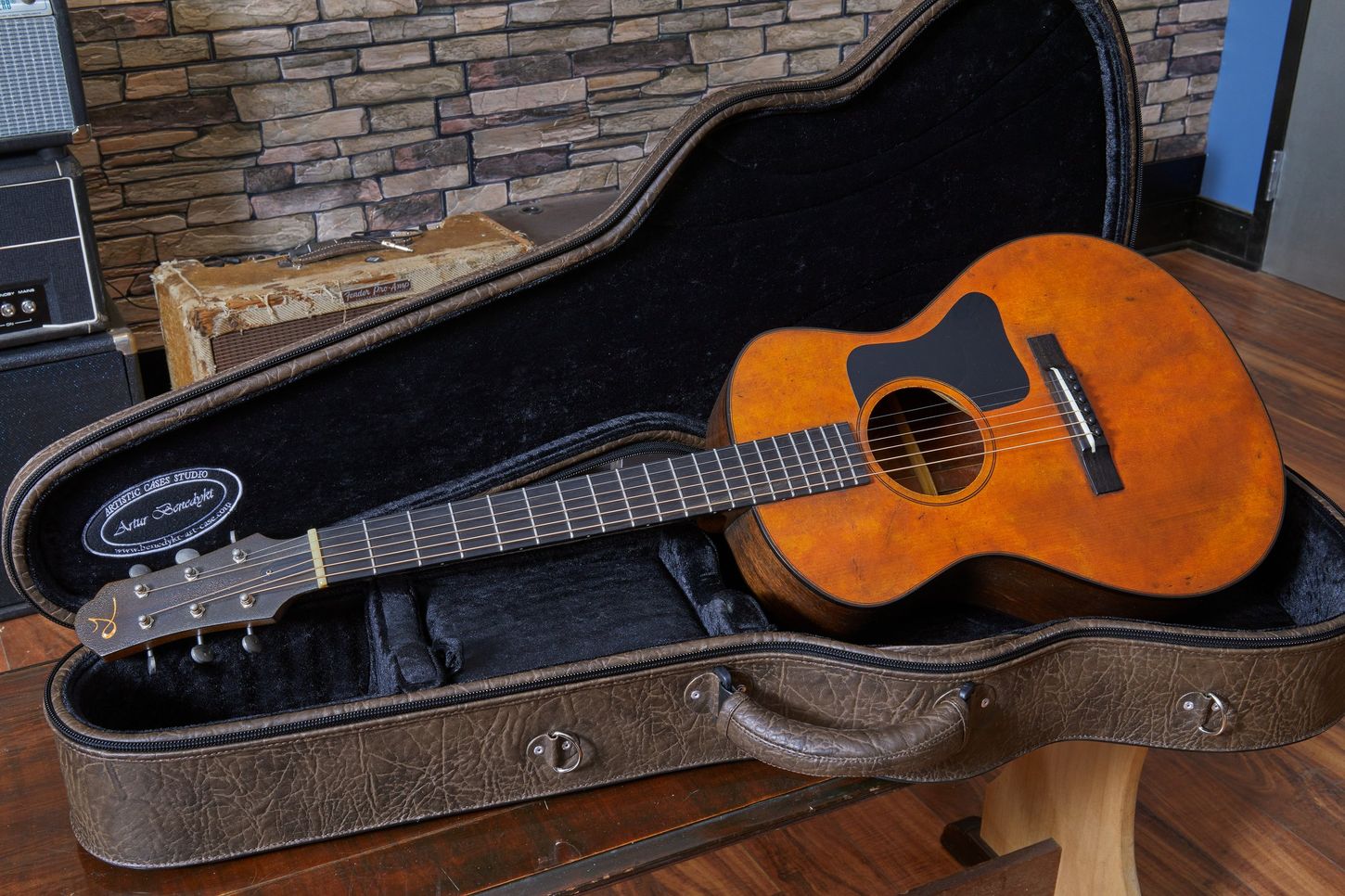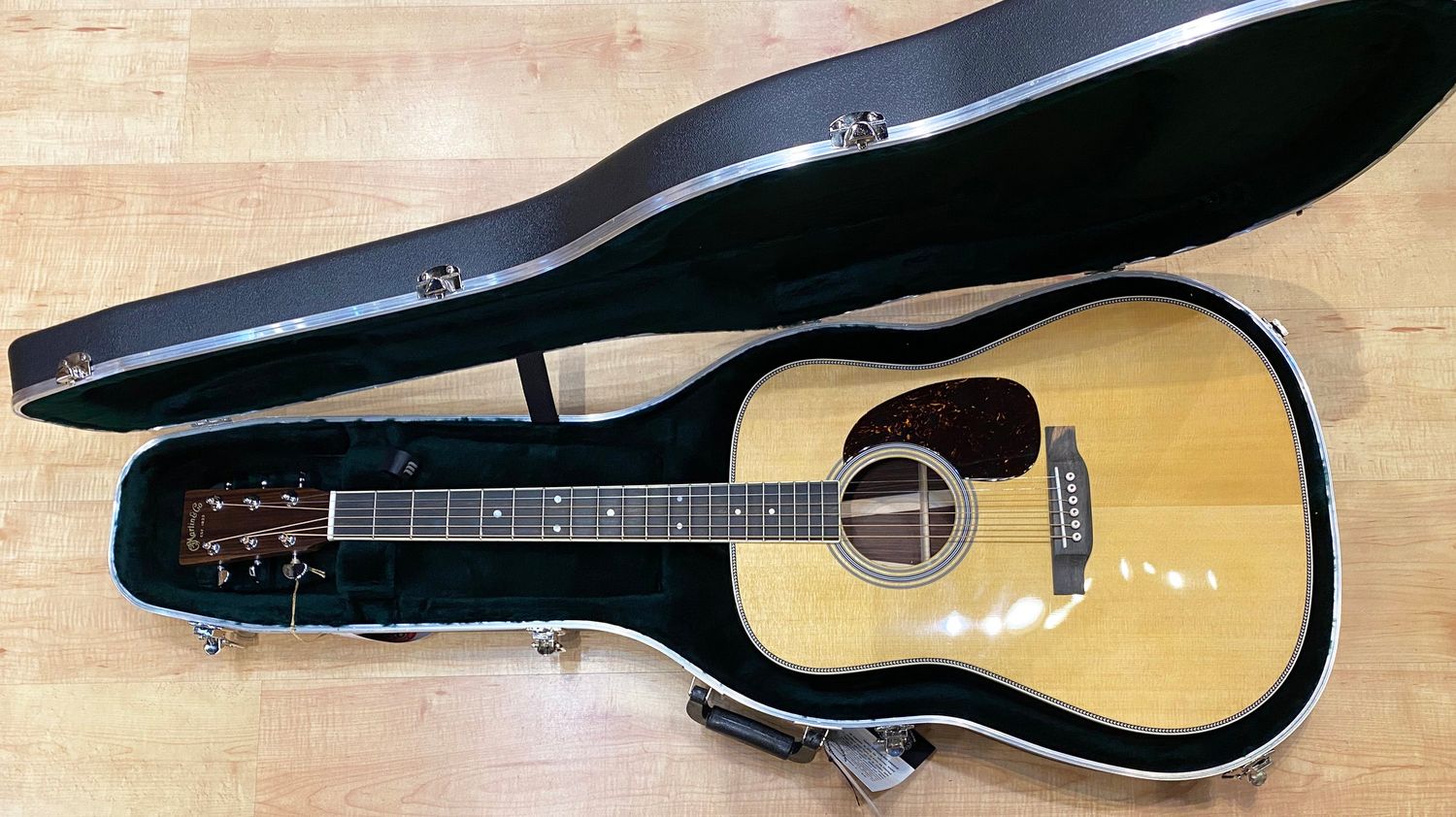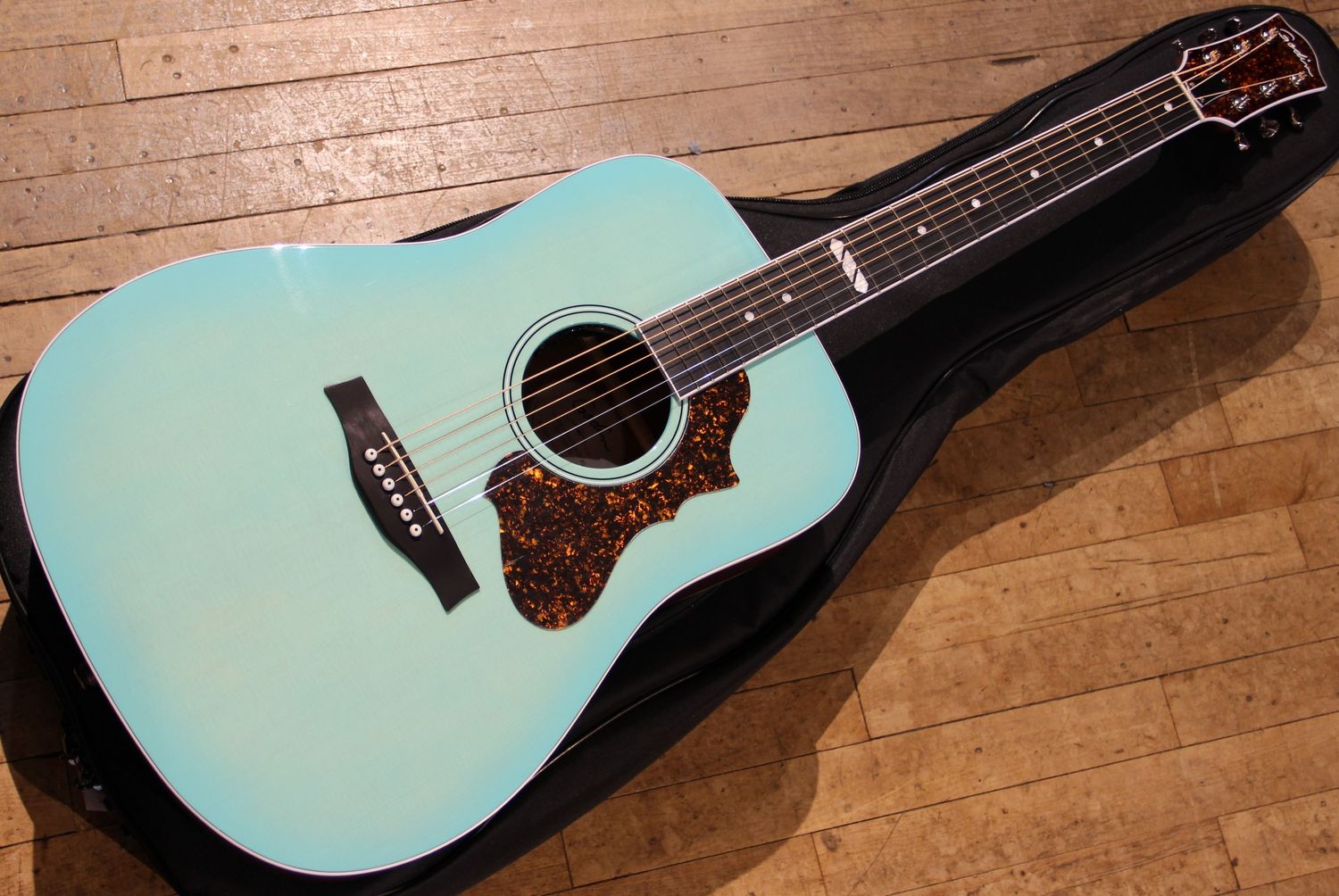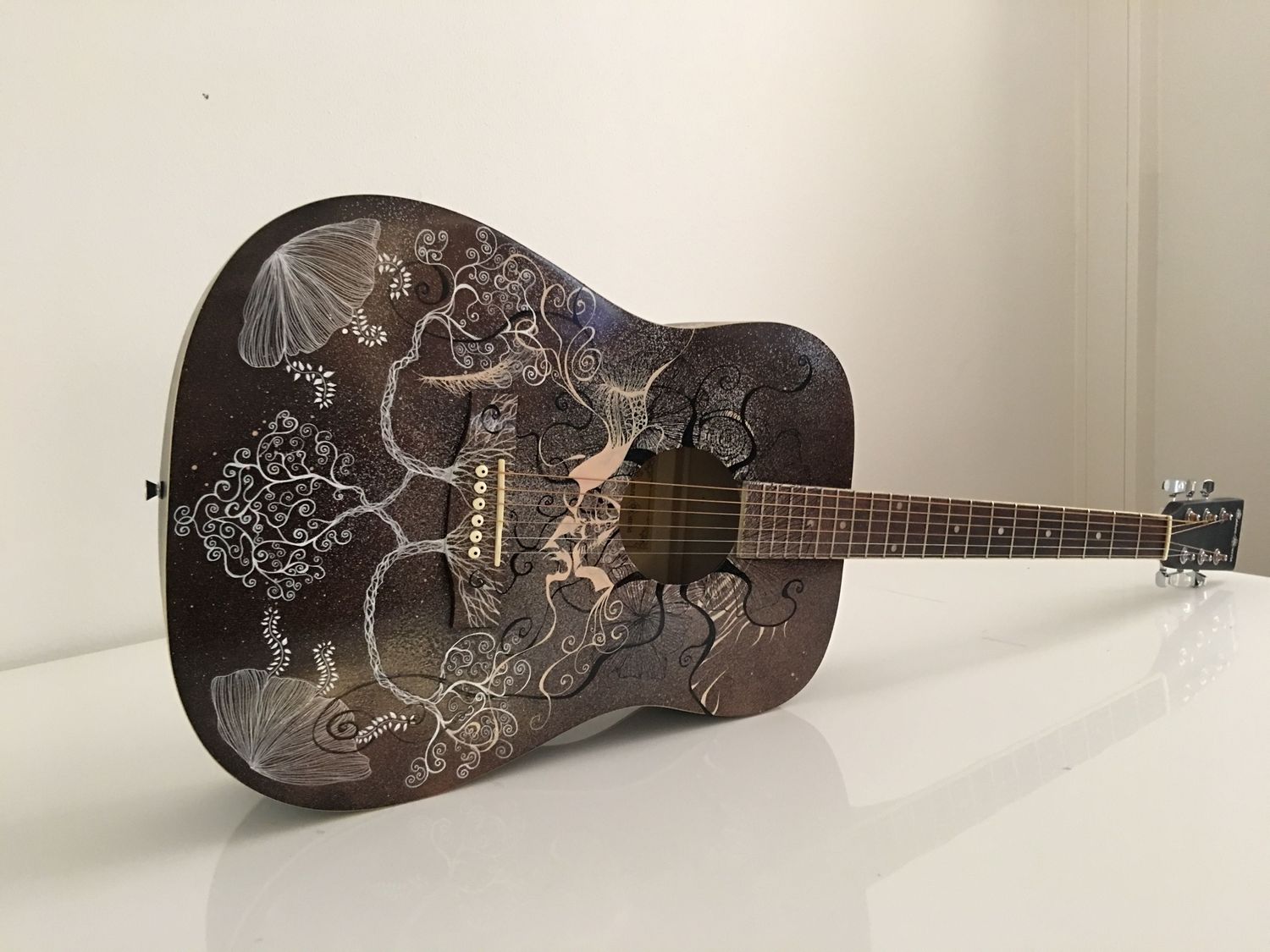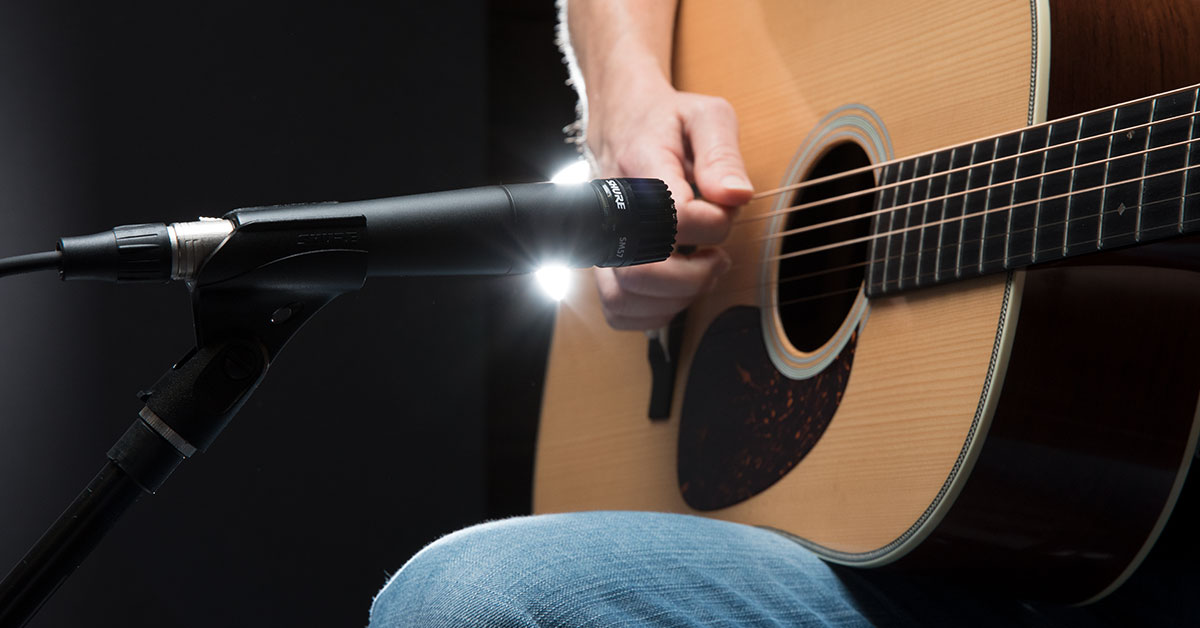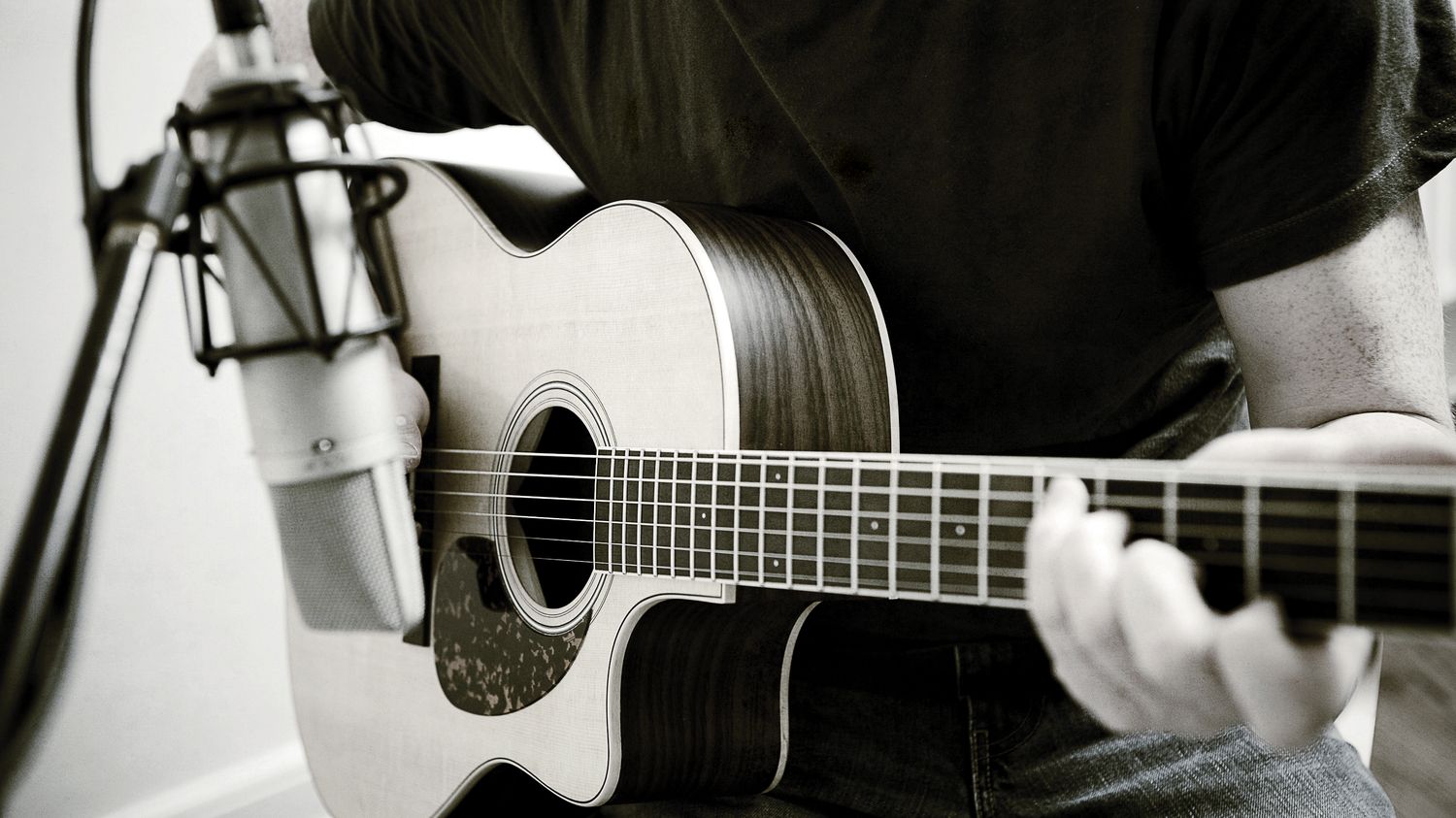Home>Production & Technology>Acoustic>How To Get Better At Acoustic Guitar


Acoustic
How To Get Better At Acoustic Guitar
Published: March 11, 2024
Learn how to improve your acoustic guitar skills with our expert tips and techniques. Master the art of playing acoustic guitar with our comprehensive guide. Start your journey to becoming a skilled acoustic guitarist today!
(Many of the links in this article redirect to a specific reviewed product. Your purchase of these products through affiliate links helps to generate commission for AudioLover.com, at no extra cost. Learn more)
Table of Contents
Choosing the Right Guitar
Selecting the right acoustic guitar is a crucial first step in your journey to becoming a skilled guitarist. With a wide array of options available, it's essential to consider several factors to ensure that you find the perfect instrument that suits your playing style and preferences.
Consider Body Style and Size
The body style of the guitar significantly impacts its sound and playability. Acoustic guitars come in various body shapes, such as dreadnought, concert, and parlor. Each style offers distinct tonal characteristics and ergonomic features. Additionally, consider the size of the guitar, especially if you're a beginner or have a smaller stature. Opting for a guitar that feels comfortable to hold and play can enhance your overall learning experience.
Evaluate Tonewoods
The choice of tonewoods greatly influences the sound produced by an acoustic guitar. Different woods, such as spruce, mahogany, cedar, and rosewood, contribute to unique tonal qualities. For instance, spruce is known for its bright and articulate sound, while mahogany offers warmth and depth. By understanding the sonic properties of various tonewoods, you can select a guitar that resonates with your musical preferences.
Test Playability and Sound
When choosing an acoustic guitar, it's essential to assess its playability and sound quality. Pay attention to the action, which refers to the distance between the strings and the fretboard. A guitar with comfortable action facilitates smooth fretting and strumming. Additionally, listen to the guitar's sound to determine if it aligns with the tonal characteristics you desire. Experiment with different guitars to find one that not only feels great in your hands but also produces a sound that inspires you.
Set a Realistic Budget
While it's tempting to splurge on a high-end acoustic guitar, it's important to set a realistic budget based on your current commitment to learning the instrument. Fortunately, there are excellent entry-level guitars that offer impressive quality at affordable prices. By establishing a budget, you can narrow down your options and focus on finding a guitar that meets your needs without breaking the bank.
Seek Expert Advice
If you're unsure about which acoustic guitar to choose, don't hesitate to seek guidance from experienced guitarists or music store professionals. Their insights can help you navigate the vast selection of guitars and make an informed decision based on your skill level, musical goals, and personal preferences.
By carefully considering these factors, you can confidently select an acoustic guitar that resonates with your musical aspirations and sets the stage for a fulfilling and enjoyable learning journey.
Proper Posture and Hand Position
Achieving the correct posture and hand position is fundamental to mastering the acoustic guitar. It not only ensures comfort during extended practice sessions but also facilitates efficient technique development and minimizes the risk of strain or injury. Here's a detailed guide to help you establish the optimal posture and hand placement for playing the acoustic guitar.
Sit Up Straight
Maintaining good posture begins with sitting up straight. Whether you're using a chair or a stool, ensure that your back is comfortably straight, allowing for unrestricted movement of your arms and hands. Avoid slouching, as it can lead to muscle tension and hinder your ability to reach certain frets or execute complex chord shapes.
Position the Guitar Correctly
Position the guitar on your dominant leg, with the instrument's body resting against your torso. This placement provides stability and allows for better access to the fretboard and strumming area. Experiment with the angle of the guitar until you find a position that feels natural and allows for easy reach across the entire fretboard.
Support the Neck
While playing, support the neck of the guitar with your non-dominant hand. The thumb should be positioned behind the neck, providing stability and facilitating smooth transitions between chords and scales. Avoid gripping the neck too tightly, as it can impede your dexterity and lead to hand fatigue.
Hand Placement on the Fretboard
When fretting notes or chords, place your fingers close to the frets to produce clear and resonant tones. This technique minimizes the effort required to press down the strings, allowing for cleaner sound production and reducing the risk of fret buzz. Additionally, ensure that your fingers are arched and positioned on the fingertips to avoid muting adjacent strings.
Strumming Hand Position
For optimal strumming, position your dominant hand comfortably above the soundhole, allowing for a smooth and controlled motion. Use your wrist to generate the strumming motion, and maintain a relaxed grip on the pick to facilitate fluid and consistent strumming patterns.
Regularly Check Your Posture
Throughout your practice sessions, periodically assess your posture and hand position. Make necessary adjustments to ensure that you're maintaining a relaxed and ergonomic stance. Over time, practicing with proper posture and hand placement will become second nature, enhancing your overall playing experience and contributing to your progress as a guitarist.
By prioritizing proper posture and hand position, you lay a solid foundation for skill development and long-term enjoyment of playing the acoustic guitar. Embrace these principles as essential components of your practice routine, and you'll soon notice improvements in your playing technique and overall comfort while honing your musical craft.
Learning Basic Chords and Strumming Patterns
Mastering basic chords and strumming patterns is a pivotal milestone in the journey of every aspiring acoustic guitarist. These foundational elements form the building blocks of countless songs across various genres, making them essential skills to develop early in your musical pursuit.
Embracing Essential Chords
Begin your chord exploration with fundamental open chords such as G, C, D, E, and A. These chords are prevalent in numerous songs and provide a solid framework for understanding chord structures and transitions. As you familiarize yourself with these basic shapes, pay close attention to the placement of your fingers and strive for clear and consistent chord voicings. Practice transitioning between these chords smoothly, ensuring that each note rings out clearly without unintended muting or buzzing.
Expanding Your Chord Vocabulary
Once you've gained proficiency with the foundational open chords, venture into the realm of barre chords and extended chord voicings. Barre chords, derived from the structure of open chords, allow you to unlock a broader spectrum of tonal possibilities and play songs in different keys. Additionally, explore suspended, augmented, and diminished chords to add depth and color to your chord progressions. Embracing a diverse chord vocabulary equips you with the versatility to interpret a wide range of musical compositions with confidence and creativity.
Nurturing Strumming Proficiency
Complementing your chord knowledge, strumming patterns form the rhythmic backbone of your guitar playing. Begin with simple downstroke and upstroke patterns, focusing on maintaining a steady tempo and consistent dynamics. As you progress, experiment with syncopated strumming patterns and incorporate percussive elements to infuse energy and groove into your playing. Pay attention to the nuances of strumming, such as accenting specific beats and employing palm muting to shape the character of your strummed passages.
Harmonizing Chords and Strumming
As you integrate chords and strumming patterns, strive to harmonize them seamlessly. Explore various strumming patterns that complement specific chord progressions, enhancing the emotional impact and rhythmic flow of the music. Embrace the art of dynamics, alternating between gentle, subdued strumming and bold, assertive strokes to convey different moods and intensities within a song. By harmonizing chords and strumming patterns effectively, you breathe life into your musical expressions and captivate listeners with engaging and evocative performances.
Embracing the Journey
Learning basic chords and strumming patterns is a continuous process that evolves alongside your musical growth. Embrace each chord change and strumming motion as an opportunity to refine your technique and deepen your musical understanding. With dedicated practice and a spirit of curiosity, you'll gradually internalize these foundational elements, paving the way for more advanced explorations in fingerstyle, arpeggios, and intricate chord progressions.
By immersing yourself in the world of basic chords and strumming patterns, you lay a robust groundwork for your acoustic guitar journey, setting the stage for boundless musical creativity and expression. Let these foundational elements serve as your companions, guiding you through the exhilarating landscape of acoustic guitar playing with unwavering enthusiasm and determination.
Practicing Fingerpicking Techniques
Fingerpicking is a captivating and versatile approach to playing the acoustic guitar, allowing for intricate melodic expression and rhythmic complexity. As you embark on the journey of mastering fingerpicking techniques, you'll delve into a world of nuanced articulation and captivating musical textures. Here's a comprehensive guide to help you navigate the realm of fingerstyle playing and cultivate proficiency in this captivating art form.
Embracing Fingerstyle Foundations
Begin your fingerpicking odyssey by acquainting yourself with fundamental fingerstyle patterns. The thumb, index, middle, and ring fingers are your primary tools for plucking the strings, each contributing to the creation of rich and resonant tones. Start with simple patterns, such as the alternating bass technique, which involves the thumb alternating between the lower strings while the fingers pluck the higher strings. This foundational pattern forms the basis for more intricate fingerstyle arrangements and provides a solid framework for developing dexterity and coordination.
Cultivating Finger Independence
As you delve deeper into fingerpicking, focus on cultivating finger independence to execute complex patterns with precision and fluidity. Engage in exercises that target individual finger strength and agility, gradually expanding your ability to perform intricate sequences and arpeggios. Practice scales and chromatic exercises using fingerstyle techniques, honing the ability to navigate the fretboard with finesse and grace. By nurturing finger independence, you'll unlock a world of expressive possibilities, enabling you to weave intricate melodies and harmonies with seamless fluidity.
Exploring Fingerstyle Repertoire
Immerse yourself in the exploration of fingerstyle repertoire, encompassing a diverse array of musical genres and styles. From folk and blues to classical and contemporary acoustic arrangements, the fingerstyle tradition offers a vast tapestry of musical expressions to discover. Select pieces that resonate with your musical sensibilities and gradually immerse yourself in their intricacies. As you interpret and internalize diverse fingerstyle compositions, you'll absorb valuable insights into phrasing, dynamics, and tonal nuances, enriching your musical vocabulary and expanding your artistic horizons.
Refining Artistic Expression
Beyond technical proficiency, fingerpicking invites you to infuse your playing with emotive depth and artistic expression. Experiment with dynamic contrasts, utilizing subtle variations in finger pressure and plucking intensity to convey a spectrum of emotions within your performances. Explore the incorporation of harmonics, percussive elements, and fret-hand techniques to add color and dimension to your fingerstyle arrangements. Embrace the art of interpretation, infusing each note and phrase with your unique musical identity, and allowing your artistic voice to resonate through the strings.
Nurturing Patience and Perseverance
The journey of mastering fingerpicking techniques is a testament to patience and perseverance. Embrace each practice session as an opportunity for growth, acknowledging that progress unfolds gradually through consistent dedication and focused effort. Celebrate small victories along the way, recognizing the incremental improvements in your fingerstyle prowess. Embrace the challenges as stepping stones toward mastery, and maintain an unwavering commitment to refining your fingerpicking artistry with unwavering dedication and passion.
Embracing the Fingerpicking Journey
As you embark on the path of mastering fingerpicking techniques, immerse yourself in the boundless creativity and expressive potential that this art form offers. Embrace the intricacies of fingerstyle playing with a spirit of curiosity and a willingness to explore new musical frontiers. With each plucked string and resonant chord, you'll forge a profound connection with the acoustic guitar, unlocking a world of melodic beauty and rhythmic intricacy. Let the enchanting realm of fingerpicking become a source of inspiration and fulfillment, guiding you toward a deeper understanding of musical expression and the limitless possibilities of the acoustic guitar.
Developing a Strong Sense of Rhythm
Cultivating a strong sense of rhythm is a cornerstone of proficient acoustic guitar playing, empowering musicians to infuse their performances with captivating groove and dynamic energy. Aspiring guitarists embark on a rhythmic journey that transcends mere technicality, delving into the heart and soul of music itself. Here's a comprehensive exploration of the multifaceted process of developing a robust sense of rhythm and its profound impact on the art of acoustic guitar playing.
Embracing Fundamental Rhythmic Elements
At the core of rhythm lies a tapestry of foundational elements, including beat, tempo, and meter. Understanding these components forms the bedrock of rhythmic proficiency, enabling guitarists to navigate musical compositions with precision and fluidity. By internalizing the pulse of a song and discerning its rhythmic structure, musicians lay the groundwork for seamless synchronization and expressive interpretation.
Harnessing the Power of Percussive Techniques
Incorporating percussive techniques into acoustic guitar playing elevates rhythmic dynamics, adding depth and texture to musical arrangements. By integrating percussive elements such as palm muting, string slapping, and rhythmic tapping, guitarists infuse their performances with percussive flair, creating a compelling rhythmic backdrop that propels the music forward with infectious momentum.
Exploring Diverse Rhythmic Styles and Genres
The exploration of diverse rhythmic styles and genres serves as a catalyst for expanding rhythmic versatility and creative expression. From the infectious syncopation of Latin rhythms to the driving pulse of blues and rock, each genre offers a unique rhythmic tapestry to unravel. By immersing themselves in varied musical traditions, guitarists broaden their rhythmic vocabulary, honing the ability to adapt to diverse rhythmic contexts and infuse their playing with stylistic authenticity.
Nurturing Syncopation and Groove
Syncopation, characterized by offbeat accents and rhythmic intricacies, infuses music with a sense of vitality and groove. Guitarists cultivate an intuitive understanding of syncopated patterns, embracing the art of playing "between the beats" to create compelling rhythmic tension and release. By nurturing a keen sense of groove, musicians imbue their performances with infectious energy, inviting listeners to sway to the irresistible pulse of the music.
Embracing the Rhythmic Tapestry
As guitarists embark on the journey of developing a strong sense of rhythm, they immerse themselves in a rich and vibrant rhythmic tapestry, woven from diverse influences and artistic inspirations. Each strummed chord and plucked note becomes a thread in this intricate fabric of rhythm, contributing to the creation of captivating musical narratives that resonate with depth and emotion.
Embracing the Rhythmic Journey
The pursuit of a strong sense of rhythm transcends technical proficiency, evolving into a profound artistic endeavor that shapes the very essence of musical expression. Guitarists embrace the rhythmic journey with unwavering dedication, allowing the pulse of the music to guide their hands and hearts. Through this rhythmic odyssey, musicians unlock the transformative power of rhythm, infusing their acoustic guitar playing with a captivating sense of vitality and rhythmic eloquence.
Understanding Music Theory and Scales
Understanding music theory and scales is a transformative journey that empowers acoustic guitarists to unravel the intricate language of music and expand their creative horizons. Delving into the realm of music theory unveils a profound understanding of the underlying principles that govern harmony, melody, and rhythm, providing a comprehensive framework for musical expression and interpretation.
At the heart of music theory lies the exploration of scales, which serve as the foundational building blocks of melody and harmony. By familiarizing themselves with scales, guitarists gain insight into the organization of musical notes and intervals, unlocking a wealth of melodic possibilities and harmonic relationships. From the timeless elegance of the major scale to the evocative allure of the minor scale, each scale embodies a distinct emotional character, offering a palette of tonal colors for artistic exploration.
As guitarists delve into the intricacies of scales, they uncover the significance of intervals and their role in shaping melodic contours and harmonic progressions. The study of intervals elucidates the unique relationships between notes, fostering a deeper appreciation for the expressive potential inherent in melodic sequences and chord structures. By internalizing the essence of intervals, guitarists cultivate a heightened sensitivity to melodic phrasing and harmonic resonance, enriching their musical interpretations with nuanced depth and emotive resonance.
Furthermore, the exploration of music theory equips guitarists with the tools to comprehend chord construction, progressions, and modal interchange, fostering a holistic understanding of the harmonic landscape. Through the study of chord theory, musicians gain insight into the intricate alchemy of chord voicings, inversions, and extensions, enabling them to craft compelling harmonic tapestries that elevate their musical compositions and improvisations.
Embracing music theory and scales as integral components of their artistic journey, guitarists embark on a transformative odyssey that transcends technical proficiency, nurturing a profound connection with the language of music itself. With each harmonic progression and melodic exploration, they immerse themselves in a world of boundless creativity and expressive potential, guided by the timeless wisdom of music theory and the captivating allure of scales.
In essence, the pursuit of understanding music theory and scales becomes a testament to the enduring power of musical knowledge, enriching the artistic tapestry of acoustic guitar playing with depth, sophistication, and emotive resonance. As guitarists embrace the transformative influence of music theory and scales, they embark on a perpetual quest for musical enlightenment, infusing their performances with a profound sense of artistic authenticity and creative ingenuity.
Utilizing Online Resources and Lessons
In the digital age, the wealth of online resources and lessons has revolutionized the landscape of acoustic guitar learning, offering a treasure trove of educational materials and interactive platforms that empower aspiring guitarists to embark on a transformative musical journey. From comprehensive video tutorials and interactive courses to virtual communities and personalized instruction, the online realm presents a myriad of avenues for acquiring knowledge, honing skills, and connecting with a global network of fellow enthusiasts.
Access to Diverse Learning Materials
Online platforms provide access to a diverse array of learning materials, catering to guitarists of all skill levels and musical preferences. From beginner-friendly tutorials that elucidate fundamental techniques to advanced masterclasses that delve into intricate musical concepts, the breadth of available resources ensures that learners can tailor their educational experience to align with their specific goals and aspirations. Additionally, the accessibility of sheet music, tablature, and backing tracks facilitates comprehensive exploration of repertoire, enabling guitarists to immerse themselves in the study of diverse musical genres and styles.
Interactive and Engaging Learning Platforms
Interactive learning platforms and virtual lesson environments foster engaging and immersive educational experiences, transcending geographical barriers and enabling students to connect with esteemed instructors and fellow learners from around the globe. Through live virtual workshops, interactive Q&A sessions, and collaborative learning forums, guitarists can engage in dynamic exchanges of knowledge, receive personalized feedback, and participate in enriching musical dialogues that nurture their growth as musicians. Furthermore, the integration of multimedia elements such as interactive diagrams, play-along exercises, and real-time demonstrations enhances the efficacy of online lessons, providing a multi-sensory approach to skill development and musical comprehension.
Community and Support Networks
Online communities and forums serve as vibrant hubs for knowledge sharing, mentorship, and camaraderie, fostering a sense of belonging and mutual encouragement among guitar enthusiasts. By participating in virtual communities, learners gain access to a wealth of collective wisdom, diverse perspectives, and collaborative learning opportunities. The exchange of insights, experiences, and creative endeavors within these digital communities cultivates a supportive and inspiring environment, empowering guitarists to navigate their learning journey with confidence and enthusiasm.
Personalized Learning Paths
Online resources and lessons offer the flexibility of personalized learning paths, allowing guitarists to tailor their educational trajectory to align with their individual pace, preferences, and areas of focus. Whether seeking to master specific techniques, explore niche musical genres, or delve into music theory, learners can curate a customized curriculum that caters to their unique musical interests and aspirations. Additionally, the availability of one-on-one virtual instruction and personalized feedback from experienced educators enables students to receive tailored guidance and mentorship, fostering accelerated growth and skill refinement.
Embracing the Digital Learning Landscape
The utilization of online resources and lessons represents a paradigm shift in the realm of acoustic guitar education, empowering learners to embrace the boundless opportunities afforded by the digital learning landscape. By harnessing the wealth of educational materials, interactive platforms, and global learning communities available online, guitarists embark on a transformative journey of musical discovery, skill development, and artistic expression, transcending traditional constraints and embracing a dynamic and interconnected approach to musical learning and growth.
Consistent and Structured Practice Routine
Establishing a consistent and structured practice routine is the cornerstone of progress and proficiency in acoustic guitar playing. By dedicating focused time to deliberate practice, aspiring guitarists lay the groundwork for skill development, musical fluency, and artistic refinement. A well-crafted practice routine serves as a compass, guiding learners through a purposeful and systematic approach to honing their craft.
Setting Clear Objectives
At the outset of crafting a practice routine, it's essential to define clear objectives that align with individual musical goals and aspirations. Whether aiming to master specific techniques, learn new repertoire, or enhance improvisational skills, articulating tangible objectives provides a roadmap for focused practice sessions. By delineating specific targets, guitarists cultivate a sense of purpose and direction, fostering a proactive mindset that fuels their dedication to consistent practice.
Time Management and Scheduling
Effective practice routines hinge on efficient time management and strategic scheduling. Allocating dedicated time slots for practice sessions within one's daily or weekly schedule ensures regular engagement with the instrument. By establishing a consistent practice schedule, guitarists cultivate a disciplined approach to skill development, fostering a sense of routine that nurtures continuity and progress. Additionally, integrating varied practice segments, such as technical exercises, repertoire study, and creative exploration, optimizes the utilization of practice time, fostering a balanced and comprehensive approach to skill refinement.
Deliberate and Focused Practice
Deliberate practice lies at the heart of a structured practice routine, emphasizing focused and mindful engagement with specific musical elements. By breaking down complex techniques or challenging passages into manageable components, guitarists can methodically address areas of improvement, gradually refining their skills with precision and intention. Furthermore, incorporating focused listening exercises, visualization techniques, and mental rehearsal into practice sessions enhances cognitive engagement and fosters holistic skill development, elevating the efficacy of deliberate practice.
Reflective Evaluation and Progress Tracking
Integrating reflective evaluation and progress tracking into the practice routine cultivates self-awareness and accountability. Regularly assessing one's performance, identifying areas of growth, and acknowledging milestones achieved instills a sense of accomplishment and motivation. Additionally, maintaining a practice journal or utilizing digital tools to track progress empowers guitarists to monitor their development, identify patterns of improvement, and adapt their practice strategies to optimize learning outcomes.
Cultivating Patience and Perseverance
A consistent and structured practice routine is a testament to the enduring virtues of patience and perseverance. Embracing the incremental nature of skill development, guitarists navigate the peaks and plateaus of their musical journey with resilience and determination. By nurturing a patient and perseverant mindset, learners cultivate a steadfast commitment to their practice routine, recognizing that each dedicated session contributes to their growth as musicians.
In essence, a consistent and structured practice routine serves as a catalyst for transformative growth and artistic fulfillment, empowering guitarists to embark on a purposeful and progressive journey of skill refinement and musical expression. Through the cultivation of clear objectives, effective time management, deliberate practice, reflective evaluation, and unwavering perseverance, aspiring guitarists forge a path of continuous improvement and creative evolution, embracing the boundless potential of their musical aspirations.


